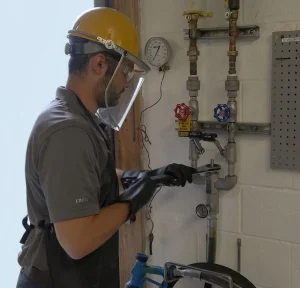5 Ways To Ensure Plant Safety in Processing Facilities
Processing facilities must ensure employees are trained and educated on proper protocols and procedures to maintain a safe working environment. Plant managers should regularly access the facility for risks and ensure sanitization procedures are followed.
Proper employee training and education
Employees are the backbone of any plant, and their knowledge and adherence to safety protocols are crucial. All-inclusive training programs should educate employees on proper hygiene practices, personal protective equipment (PPE) use, and equipment handling.
“Regular refresher courses and ongoing education initiatives will help reinforce safety protocols and keep employees informed about the latest processing industry standards,” said Glenn Quinty, senior design engineer at ThermOmegaTech.
Assess facility risks
Conducting a thorough risk assessment is necessary to identify and understand potential hazards within the plant. This assessment involves analyzing the processes, machinery, chemicals, and work environments to pinpoint possible sources of danger. Once identified, appropriate control measures can be implemented to mitigate risks and minimize the likelihood of accidents.
Develop proper sanitization procedures
Cleaning and sanitizing chemical, pharmaceutical, food, and beverage processing equipment is critical to maintaining hygiene and operational efficiency. These facilities can offer microscopic places for germs and pathogens to hide, especially in cracks and scratches.
Effective sanitization practices should include regularly cleaning and disinfecting all surfaces and equipment. Washdown stations are a part of those best practices.
“Using a washdown unit like ThermOmegaTech’s STVM Station that combines steam and water to provide a high-temperature wash has several benefits. Steam and water mixing stations provide instantaneous steam-heated water with pressure behind it, which can kill bacteria, sterilize and break down greases and other residues in processing plants,” Quinty said.
“When factoring in the amount of volume that the steam occupies in the pipe, as it is compressible, it allows more energy transfer per pipeline distribution size than water or electricity. This washdown station sanitizes equipment efficiently and prevents contamination while complying with industry standards,” he said.
Implement emergency safety equipment
Installing emergency equipment to protect personnel is vital to workplace safety. Occupational Safety and Health Administration (OSHA) regulations address the need for emergency eyewash and shower stations in 1910.151(c) but do not go into specific requirements for the equipment. The American National Standards Institute (ANSI) Z358.1 standard is the widely accepted guideline for adequately selecting, installing, operating, and maintaining emergency showers, eyewashes, eye/face washes, and combination units.
ANZI Z358.1 addresses where and how to install the equipment and the flushing liquid’s velocity, pressure and temperature. If a person is exposed to a dangerous substance, they need to flush the area of their body exposed with tepid water as quickly as possible. Using tepid water prevents scalding and low-temperature shock.
Various solutions exist for tepid water delivery to these stations, including mixing valves, electric water heaters, and instantaneous electric or steam heater systems.
Strict adherence to regulations and industry standards
Adhering to relevant safety regulations and industry standards is non-negotiable. Compliance with legal requirements ensures that the plant operates within established parameters. Regular audits and inspections should be conducted to verify compliance and identify improvement areas.
Maintaining and enforcing employee training and education initiatives, assessing facility risks, following proper sanitization procedures and implementing emergency safety equipment are all ways to ensure your employees are at their safest while working daily.
Questions on how to make your plant or facility safer? Contact ThermOmegaTech here.
This article ran on January 18, 2024, in Plant Engineering magazine. Read the full feature here.
